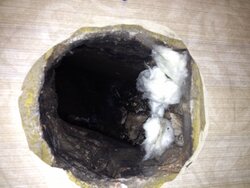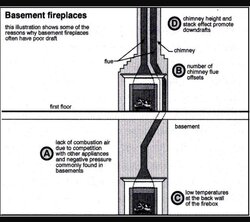Ok,
Things have changed for me a lot. So we moved and bought a house a week ago and I'm already looking at wanting a wood stove installed.
The house was built in 1972 and has a double masonry chimney on the exterior of the house. The larger Terra cotta lined chimney services the upstairs fireplace while the smaller chimney goes down to the daylight basement where there was an "Earth Stove" installed years ago.
During the home inspections the chimney sweep stated the smaller Terra cotta chimney was an 8x13" flue. They also said the chimnies needed cleaning and some sealing.
These repairs were stated to be completed as part of the purchase agreement. After we bought the house I looked at the smaller chimney today and it definitely was not cleaned. Has old soot and cresote in it and no evidence of cleaning what so ever... Ok enough nagging.
My question is, I want to install an Ideal Steel Hybrid in the basement utilizing the small chimney. While looking at it today I measured it and it looked like the inside diameter is 7" x 12".
Seeing what the chimney looked like I want to install a SS liner down the chimney. Is there going to be room to install a 6" liner down this setup?
I want it to be insulated, is this going to be possible?
If not Ive heard of people breaking out the Terra cotta tiles to fit insulated liners. Is this an option too?
Here are a few pictures of the location they took the thimble out of the wall and where the chimney starts.
Things have changed for me a lot. So we moved and bought a house a week ago and I'm already looking at wanting a wood stove installed.
The house was built in 1972 and has a double masonry chimney on the exterior of the house. The larger Terra cotta lined chimney services the upstairs fireplace while the smaller chimney goes down to the daylight basement where there was an "Earth Stove" installed years ago.
During the home inspections the chimney sweep stated the smaller Terra cotta chimney was an 8x13" flue. They also said the chimnies needed cleaning and some sealing.
These repairs were stated to be completed as part of the purchase agreement. After we bought the house I looked at the smaller chimney today and it definitely was not cleaned. Has old soot and cresote in it and no evidence of cleaning what so ever... Ok enough nagging.
My question is, I want to install an Ideal Steel Hybrid in the basement utilizing the small chimney. While looking at it today I measured it and it looked like the inside diameter is 7" x 12".
Seeing what the chimney looked like I want to install a SS liner down the chimney. Is there going to be room to install a 6" liner down this setup?
I want it to be insulated, is this going to be possible?
If not Ive heard of people breaking out the Terra cotta tiles to fit insulated liners. Is this an option too?
Here are a few pictures of the location they took the thimble out of the wall and where the chimney starts.



